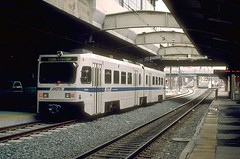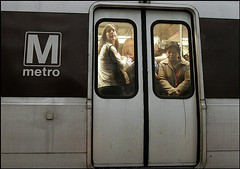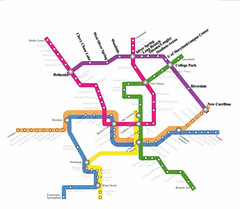An alternative idea to expanding WMATA from Greenbelt to BWI Airport
 Light rail at Penn Station, Baltimore.
Light rail at Penn Station, Baltimore.Gerald Neily writes on the EnvisionBaltimore e-list:
Here's another mind expanding idea that you're seeing here first.
There are some very good reasons why the proposed BWI-M to Greenbelt transit line should be built as an extension of the Baltimore Central Light Rail Line instead of as an extension of the Washington Metro. (Saving money by building light rail instead of heavy rail isn't even one of them, since a light rail line that is built to the same performance standards as heavy rail would cost approximately as much.)
Reason #1: The transfer point should be located at the station where the greatest number of transfers would take place. It is not likely that BWI-M would be that station. In the long run, the link between Baltimore and Washington is likely to be much more important than the links from either area to the airport.
It is possible that some other station between BWI-M and Greenbelt may be the highest volume location, or that Greenbelt itself would be the location, or that the Green Metro Line between Greenbelt and College Park or Fort Totten should be retrofitted to accommodate a combination of heavy and high platform light rail vehicles. This assumes that the light rail line as a whole would be converted to high platforms south of Downtown Baltimore (see previous posting), as the Central Light Rail Line is reinvented to promote the vision of the 2002 regional rail plan.
 Washington Post photo by Nikki Kahn.
Washington Post photo by Nikki Kahn.Reason #2: The number of transfers at College Park would increase greatly when and if the Purple Line was constructed, which would provide connections to Bethesda, Silver Spring, New Carrollton and other intervening points.
Reason #3: The DC Metro Purple Line and the Baltimore Central Light Rail Line could be merged into a single continuous light rail line providing one-seat service between Bethesda and Downtown Baltimore. Between the College Park and Greenbelt Metro Stations, the existing Green Line could be retrofitted to accommodate light rail even if additional new platforms were needed to be built for use by low platform light rail vehicles. As such, the Metro Purple Line and Green Line Extension to BWI-M should be seen as complementary rather than competing projects.
 A proposed Purple Line Metro Map.
A proposed Purple Line Metro Map.Reason #4: The existing single track light rail terminus at BWI-M would no doubt have to be torn out anyway under any new transit extension project, and replaced with an entirely new integral design that would facilitate through movements as well as airport passengers. With a blank slate, there is no point in not doing it right.
Reason #5: These projects are to be built and administered by the State of Maryland, not Washington DC. They should therefore best serve the people of Maryland, who are located in Montgomery, Prince Georges, Howard, Anne Arundel, Baltimore County and Baltimore City, and not in the District of Columbia. These areas are also growing much more rapidly than is the District and have much more potential for new transit-oriented development, beyond what is already anticipated, than the District's Green Line Stations.
I might not agree with every point, especially administration (I mean, why shouldn't MTA's rail services not be contracted out to WMATA at some point...). Still pretty interesting.
Index Keywords: transit



0 Comments:
Post a Comment
<< Home